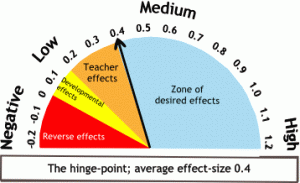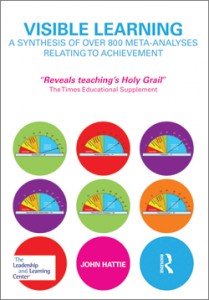This is the final post in a ten part blog series (you may click here to start from the beginning).
Much has been written in the past few years about the research of John Hattie and his impressive Visible Learning meta-analyses synthesis. His work has given educators quantifiable insights that have no parallel in the field of education. The weight of over 800 meta-analyses related to achievement, based on over 50,000 studies involving millions of students, certainly demands attention and respect.
This blog series serves to highlight his most significant findings and their applications to our classrooms from Hattie’s 2012 work, Visible Learning for Teachers: Maximizing Impact on Learning. Each blog in the series highlights a different finding that ranked in the top 10 out of 150 areas studied, in regard to effect size, from Hattie’s research. If you are familiar with Hattie’s research, this blog series may serve as a valuable reminder of the findings. If you are not familiar with Hattie’s works, hopefully you will see these findings are worth sharing and resharing, reading and rereading, and applying and reapplying as they are recognized as best practice in our field.
Need an introduction or a crash course on the effect sizes referenced below? An effect size of 0.40 is what Hattie refers to as a hinge-point regarding what is significantly effective or at “a level where the effects of innovation enhance achievement in such a way that we can notice real-world differences” (Hattie, 2009). Anything between a 0.00 and 0.39 is growth, but is not considered significant growth. Anything below a 0.00 is considered detrimental to student growth.

Number 1 – Self-Reported Grades/Student Expectations (effect size = 1.44)
Students are highly attuned at estimating their own performance. Hattie interprets this with two specific takeaways, one more positive than the other. First, the high level of predictability about classroom achievement questions “the necessity of so many tests when students appear to already have much of the information the tests supposedly provide.” Second, these student expectations “may become a barrier for some students as they may only perform to whatever expectations they already have of their ability” (p. 44, 2009).
Application to the Classroom
In reflecting upon the massive effect size of this specific area it is striking how fixed the findings present themselves. However, recent research around the concept of growth mindset may be the leverage self-reported grades and student expectations need in order to capitalize and maximize its impact in our classrooms. 
Carol Dweck is the leading researcher in field of growth mindset. Growth mindset is grounded in the belief that intelligence is not fixed and that anyone can learn and improve their performance. She compares our brains to muscles that can grow and strengthen through hard work and persistence. Her research has found that intelligence is malleable and anyone can change their mindset.
In your classroom, if you can combine the growth mindset philosophy of Dweck with the research findings of Hattie you will have students who believe they can grow and perform at high levels and can predict their performance with a high level of accuracy. A wonderfully dangerous combination for student achievement!
Number 94 out of 150 – Homework (effect size 0.29)
Hattie finds that the overall effects of homework are positive, “but there are some important moderators.” The older the student the greater impact homework has on learning, with high school benefitting two times more than middle school students and middle school students benefitting two times more than elementary students. The impact was greatest when the material was not complex, when it was novel, and when students were of a higher ability level.
A Peek at the Bottom 10
Number 141 out of 150 – Ethnic Diversity of Students (effect size 0.05)
Hattie does not dedicate any page space to explaining this specific area.
For more from this blog series view the following posts:
#8 – Comprehensive Interventions for Learning Disabled Students
#5 – Providing Formative Evaluation of Programs
Hattie, J., Visible Learning: A Synthesis of Over 800 Meta-Analyses Relating to Achievement (2009)
Hattie, J. Visible Learning for Teachers: Maximizing Impact on Learning (2012)
Carol Dweck Revisits Growth Mindset: http://www.edweek.org/ew/articles/2015/09/23/carol-dweck-revisits-the-growth-mindset.html
The Effort Effect: https://alumni.stanford.edu/get/page/magazine/article/?article_id=32124
Growth mindset image retrieved from: http://www.edweek.org/ew/articles/2015/09/23/carol-dweck-revisits-the-growth-mindset.html
Effect size image retrieved from: http://www.learningandteaching.info/teaching/what_works.htm






Leave a Reply